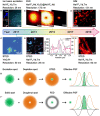Lanthanide-Doped Upconversion Nanoparticles for Super-Resolution Microscopy
- PMID: 33520938
- PMCID: PMC7843451
- DOI: 10.3389/fchem.2020.619377
Lanthanide-Doped Upconversion Nanoparticles for Super-Resolution Microscopy
Abstract
Super-resolution microscopy offers a non-invasive and real-time tool for probing the subcellular structures and activities on nanometer precision. Exploring adequate luminescent probes is a great concern for acquiring higher-resolution image. Benefiting from the atomic-like transitions among real energy levels, lanthanide-doped upconversion nanoparticles are featured by unique optical properties including excellent photostability, large anti-Stokes shifts, multicolor narrowband emissions, tunable emission lifetimes, etc. The past few years have witnessed the development of upconversion nanoparticles as probes for super-resolution imaging studies. To date, the optimal resolution reached 28 nm (λ/36) for single nanoparticles and 82 nm (λ/12) for cytoskeleton structures with upconversion nanoparticles. Compared with conventional probes such as organic dyes and quantum dots, upconversion nanoparticle-related super-resolution microscopy is still in the preliminary stage, and both opportunities and challenges exist. In this perspective article, we summarized the recent advances of upconversion nanoparticles for super-resolution microscopy and projected the future directions of this emerging field. This perspective article should be enlightening for designing efficient upconversion nanoprobes for super-resolution imaging and promote the development of upconversion nanoprobes for cell biology applications.
Keywords: STED; lanthanide; multiphoton imaging; super-resolution microscopy; upconversion nanoparticle.
Copyright © 2021 Dong, Sun and Yan.
Conflict of interest statement
The authors declare that the research was conducted in the absence of any commercial or financial relationships that could be construed as a potential conflict of interest.
Figures


References
-
- Abbe E. (1873). Beiträge zur theorie des mikroskops und der micrkoskopischen wahrnehmung. Arch. Mikrosk. Anat. 9, 413–468. 10.1007/BF02956173 - DOI
-
- Bednarkiewicz A., Chan E. M., Kotulska A., Marciniak L., Prorok K. (2019). Photon avalanche in lanthanide doped nanoparticles for biomedical applications: super-resolution imaging. Nanoscale Horiz. 4, 881–889. 10.1039/C9NH00089E - DOI
LinkOut - more resources
Full Text Sources
Other Literature Sources
Miscellaneous

